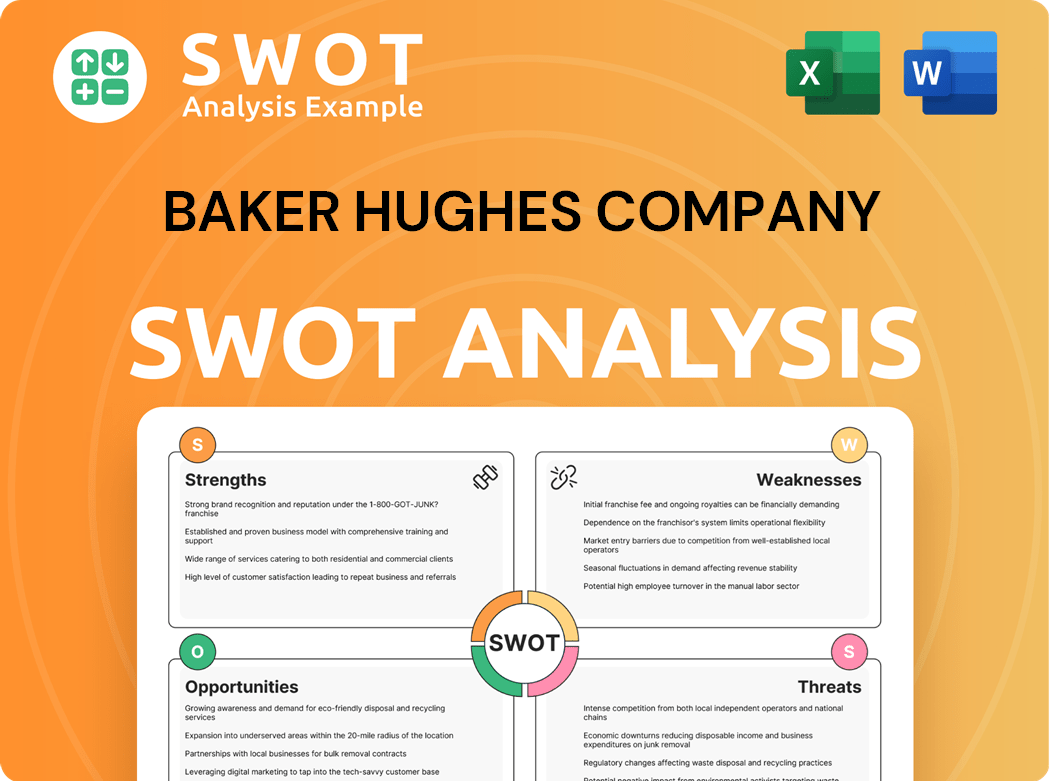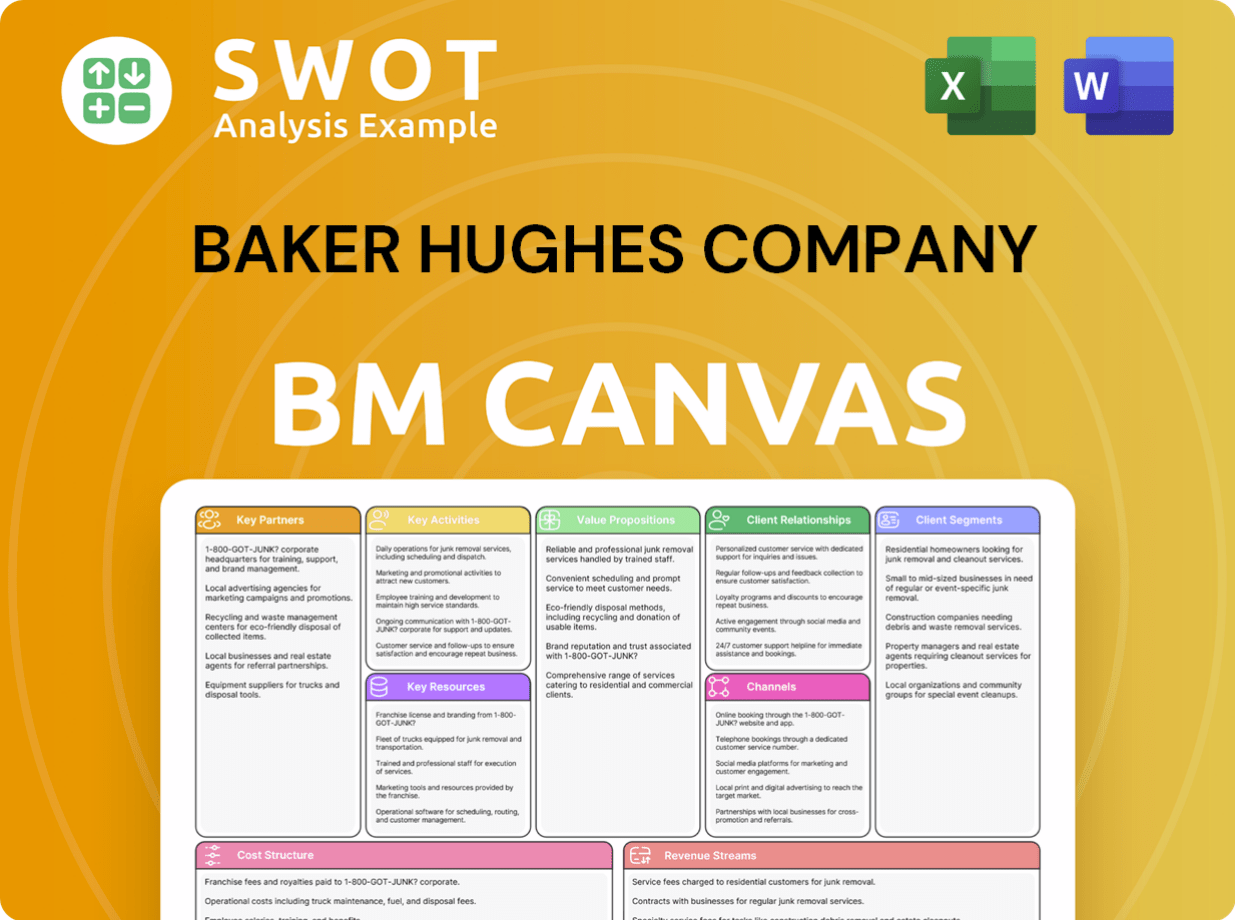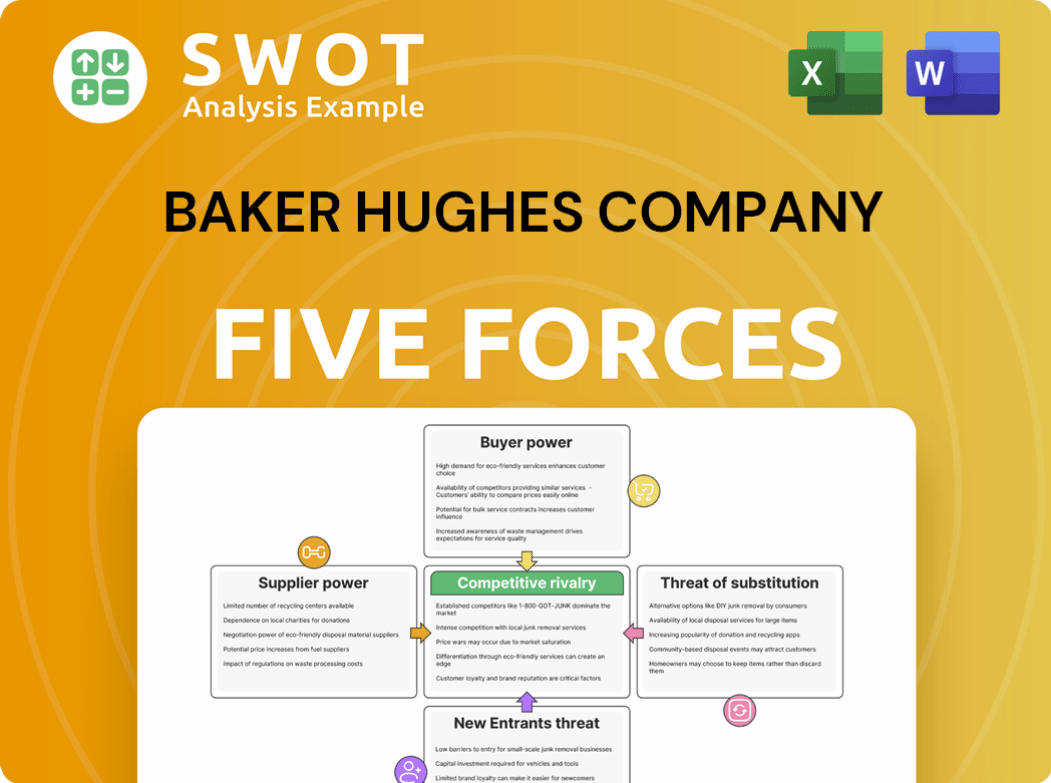Baker Hughes Company Bundle
How Does Baker Hughes Navigate the Fierce Energy Sector Competition?
The energy sector is a battlefield of innovation and strategic maneuvering, and Baker Hughes Company is a key player in this dynamic environment. Understanding the Baker Hughes Company SWOT Analysis is crucial for investors and strategists alike. This analysis delves into the company's competitive positioning, market dynamics, and future prospects.

To truly grasp Baker Hughes's standing, we must dissect its competitive landscape. This exploration will identify its main competitors within the oilfield services industry, providing a detailed Baker Hughes market analysis. We will assess its strengths, weaknesses, opportunities, and threats in the context of the broader energy sector competition.
Where Does Baker Hughes Company’ Stand in the Current Market?
Baker Hughes holds a significant position in the energy technology and services sector. It operates across Oilfield Services (OFS), Industrial & Energy Technology (IET), and Digital Solutions. The company is consistently ranked among the top global energy service providers, competing with companies like Schlumberger and Halliburton. Its services cover drilling, well construction, production solutions, and more, serving a diverse customer base including national and international oil companies.
The company's strategic focus includes digital transformation and new energy solutions. This shift aligns with industry trends toward decarbonization and efficiency. Baker Hughes is investing in areas like carbon capture, hydrogen, and geothermal energy to diversify its offerings. This strategic move aims to position the company for long-term growth in a changing energy landscape, addressing the evolving needs of its customers and the broader market.
Baker Hughes reported revenues of $25.5 billion for 2023, marking a 13% increase year-over-year. The adjusted operating income for Q1 2024 was $808 million, highlighting solid profitability. These figures demonstrate its financial strength, supporting continued investment in research and development and strategic acquisitions. The company's robust financial performance enables it to maintain a competitive edge in the industry, driving innovation and expansion.
Baker Hughes operates through two main segments: Oilfield Services (OFS) and Industrial & Energy Technology (IET). OFS provides services and equipment for oil and gas exploration and production. IET focuses on industrial applications, including turbomachinery and process solutions, as well as new energy ventures.
The company has a global footprint, serving customers in over 120 countries. It has a strong presence in North America, Latin America, Europe, Africa, the Middle East, and Asia Pacific. This wide reach allows it to serve a diverse range of clients and adapt to regional market dynamics.
Baker Hughes is a leading player in the oilfield services industry. While specific market share figures fluctuate, the company consistently ranks among the top three globally. The company competes directly with Schlumberger and Halliburton for market share in various service lines.
In 2023, Baker Hughes reported revenues of $25.5 billion, reflecting strong performance. The adjusted operating income for Q1 2024 was $808 million. These financial results demonstrate the company's ability to generate revenue and maintain profitability in a competitive market.
Baker Hughes benefits from its global presence, comprehensive service offerings, and technological innovation. Its strong relationships with major oil and gas companies and its expanding portfolio in new energy solutions provide a competitive edge. The company's focus on digital solutions and its commitment to sustainability also enhance its market position.
- Global footprint across over 120 countries.
- Diversified service offerings, including digital solutions.
- Strong financial performance with revenue growth.
- Strategic focus on new energy technologies.
Baker Hughes Company SWOT Analysis
- Complete SWOT Breakdown
- Fully Customizable
- Editable in Excel & Word
- Professional Formatting
- Investor-Ready Format

Who Are the Main Competitors Challenging Baker Hughes Company?
The Baker Hughes competitive landscape is characterized by intense rivalry across its diverse business segments. The company faces significant competition from both direct and indirect rivals. Understanding the competitive dynamics is crucial for assessing its market position and future prospects. This analysis provides a detailed overview of the key players and their strategies.
Baker Hughes market analysis reveals that the company competes in the oilfield services industry and the industrial and energy technology sectors. The competitive environment is dynamic, shaped by technological advancements, market consolidation, and the evolving energy transition. This includes competition from established giants and emerging players in the new energy space.
To gain a comprehensive understanding, a look at the Brief History of Baker Hughes Company may provide a better context of the company's current position.
The primary direct competitors of Baker Hughes in the oilfield services sector are Schlumberger and Halliburton. These companies offer similar services and products, competing for market share globally. Schlumberger and Halliburton are the two largest companies in the oilfield services industry.
Schlumberger is often considered the largest oilfield services company. It offers a comprehensive portfolio spanning exploration, drilling, production, and digital solutions. Schlumberger has a broad global reach and invests significantly in technological innovation, particularly in digital and integrated services. In the first quarter of 2024, Schlumberger reported revenues of approximately $8.7 billion.
Halliburton has a strong presence in North America and expertise in hydraulic fracturing and unconventional resources. It competes directly with Baker Hughes in drilling and completion services, often through competitive pricing and operational efficiency. Halliburton reported revenues of around $5.7 billion in the first quarter of 2024.
Other significant competitors include Weatherford International and National Oilwell Varco (NOV). These companies challenge Baker Hughes through specialized offerings and regional strengths. These companies compete with Baker Hughes through specialized offerings and regional strengths.
Weatherford provides drilling, evaluation, completion, and production solutions. It competes with Baker Hughes in various service lines. Weatherford's revenue for the first quarter of 2024 was approximately $1.2 billion.
NOV is a leading provider of equipment and components for oil and gas drilling and production. It competes with Baker Hughes in the equipment supply segment. NOV's revenue for the first quarter of 2024 was around $2.5 billion.
In the industrial and energy technology segments, Baker Hughes faces competition from a broader array of companies. This includes companies offering turbomachinery and process solutions, as well as those in the digital solutions space. The competitive landscape is also being shaped by new and emerging players, particularly in the new energy sector.
- Turbomachinery and Process Solutions: Competitors include General Electric (GE), Siemens Energy, and Mitsubishi Heavy Industries. These companies offer similar equipment and services for power generation and industrial applications.
- Digital Solutions: Baker Hughes competes with technology firms like AVEVA (part of Schneider Electric) and AspenTech, as well as internal digital initiatives from major energy companies.
- New Energy Sector: Companies focused on renewable energy technologies, carbon capture, and hydrogen production are emerging as indirect competitors, vying for investment and market share in the broader energy transition.
- Mergers and Alliances: The acquisition of GE Oil & Gas by Baker Hughes in 2017, which formed Baker Hughes, a GE company (before GE divested its majority stake), significantly reshaped competitive dynamics.
Baker Hughes Company PESTLE Analysis
- Covers All 6 PESTLE Categories
- No Research Needed – Save Hours of Work
- Built by Experts, Trusted by Consultants
- Instant Download, Ready to Use
- 100% Editable, Fully Customizable

What Gives Baker Hughes Company a Competitive Edge Over Its Rivals?
The competitive landscape for Baker Hughes is shaped by its technological prowess, integrated service offerings, and global reach. The company navigates a dynamic industry, facing challenges and opportunities in the oilfield services and broader energy technology sectors. Understanding the competitive advantages of Baker Hughes is crucial for assessing its market position and future prospects.
Baker Hughes has consistently demonstrated its commitment to innovation and strategic expansion. Recent moves include investments in digital solutions and sustainable energy technologies, reflecting its adaptation to changing market demands. These strategic initiatives are vital for maintaining a competitive edge in an industry where technological advancements and environmental concerns are paramount.
The company's ability to offer comprehensive solutions across various energy sectors, including oilfield services, industrial, and digital solutions, provides a significant advantage. This integrated approach allows Baker Hughes to serve a diverse customer base and capitalize on emerging opportunities in the energy transition.
Baker Hughes' competitive advantage stems from its advanced technologies and intellectual property. Innovations in drilling systems, subsea production, and advanced materials enable more efficient operations. The company's focus on R&D and continuous product introductions supports its technological leadership.
The company's broad and integrated portfolio across Oilfield Services, Industrial & Energy Technology, and Digital Solutions is a key differentiator. This allows for end-to-end solutions, reducing complexity for customers and creating cross-selling opportunities. This comprehensive approach enhances its market position.
A global operational footprint, spanning over 120 countries, provides an extensive distribution network and local presence. This enables Baker Hughes to respond rapidly to customer needs and adapt to regional market conditions. This extensive reach supports its competitive advantage in the oilfield services industry.
Baker Hughes benefits from strong brand equity and long-standing customer relationships. These relationships, cultivated over decades, provide a solid foundation for repeat business and market stability. This established trust is a key asset in the competitive landscape.
Baker Hughes' competitive advantages include technological innovation, an integrated service portfolio, and a global presence. These strengths are crucial in the oilfield services industry. The company's focus on R&D and its ability to provide comprehensive solutions differentiate it from competitors.
- Technological Innovation: Continuous investment in R&D, leading to advanced drilling systems and subsea production technologies.
- Integrated Portfolio: Offering end-to-end solutions across oilfield services, industrial, and digital solutions.
- Global Footprint: Operating in over 120 countries, providing extensive distribution and local support.
- Customer Relationships: Strong brand equity and long-standing relationships with key customers.
Baker Hughes Company Business Model Canvas
- Complete 9-Block Business Model Canvas
- Effortlessly Communicate Your Business Strategy
- Investor-Ready BMC Format
- 100% Editable and Customizable
- Clear and Structured Layout

What Industry Trends Are Reshaping Baker Hughes Company’s Competitive Landscape?
The Baker Hughes competitive landscape is significantly shaped by the evolving energy industry, marked by the energy transition and technological advancements. The company faces both challenges and opportunities as it navigates these shifts, focusing on sustainable energy solutions and digital innovation. Understanding the company's position requires analyzing its strategies in response to market dynamics and competitor actions.
Risks include geopolitical instability, fluctuating commodity prices, and regulatory changes. The future outlook for Baker Hughes hinges on its ability to adapt to the energy transition, manage supply chain disruptions, and maintain a competitive edge through innovation and strategic partnerships. The company's financial performance and market share are critical indicators of its success in this dynamic environment.
The energy industry is undergoing a major shift toward lower-carbon solutions and renewable energy sources. Technological advancements in digitalization, AI, and automation are transforming the energy value chain. Regulatory changes aimed at reducing emissions and promoting environmental stewardship also play a crucial role.
Navigating the complexities of the multi-speed energy transition is a key challenge. Managing supply chain disruptions and attracting top talent in a competitive environment are also significant hurdles. Geopolitical instability and fluctuating commodity prices continue to impact investment decisions.
There is significant growth potential in liquefied natural gas (LNG) and gas infrastructure. Expanding digital solutions and investing in new energy technologies, such as carbon capture and hydrogen, offer promising avenues. Strategic positioning to capitalize on global energy security concerns is also beneficial.
Baker Hughes is deploying strategies focused on portfolio simplification and operational efficiency. Aggressive investment in new energy technologies and digital solutions is a key focus. The company is adapting to a changing world by providing solutions for a more sustainable energy future.
To maintain its competitive position, Baker Hughes is focusing on several key areas, including the energy transition and digital solutions. These strategies are designed to ensure long-term growth and sustainability in the face of evolving market conditions. For more details on the company's overall strategy, you can read an article about Baker Hughes Company.
- Energy Transition: Investing in carbon capture, hydrogen, and geothermal energy.
- Digital Solutions: Expanding its portfolio of software and services for operational efficiency.
- Operational Efficiency: Streamlining processes and improving supply chain management.
- Portfolio Simplification: Focusing on core competencies and strategic growth areas.
Baker Hughes Company Porter's Five Forces Analysis
- Covers All 5 Competitive Forces in Detail
- Structured for Consultants, Students, and Founders
- 100% Editable in Microsoft Word & Excel
- Instant Digital Download – Use Immediately
- Compatible with Mac & PC – Fully Unlocked

Related Blogs
- What are Mission Vision & Core Values of Baker Hughes Company Company?
- What is Growth Strategy and Future Prospects of Baker Hughes Company Company?
- How Does Baker Hughes Company Company Work?
- What is Sales and Marketing Strategy of Baker Hughes Company Company?
- What is Brief History of Baker Hughes Company Company?
- Who Owns Baker Hughes Company Company?
- What is Customer Demographics and Target Market of Baker Hughes Company Company?
Disclaimer
All information, articles, and product details provided on this website are for general informational and educational purposes only. We do not claim any ownership over, nor do we intend to infringe upon, any trademarks, copyrights, logos, brand names, or other intellectual property mentioned or depicted on this site. Such intellectual property remains the property of its respective owners, and any references here are made solely for identification or informational purposes, without implying any affiliation, endorsement, or partnership.
We make no representations or warranties, express or implied, regarding the accuracy, completeness, or suitability of any content or products presented. Nothing on this website should be construed as legal, tax, investment, financial, medical, or other professional advice. In addition, no part of this site—including articles or product references—constitutes a solicitation, recommendation, endorsement, advertisement, or offer to buy or sell any securities, franchises, or other financial instruments, particularly in jurisdictions where such activity would be unlawful.
All content is of a general nature and may not address the specific circumstances of any individual or entity. It is not a substitute for professional advice or services. Any actions you take based on the information provided here are strictly at your own risk. You accept full responsibility for any decisions or outcomes arising from your use of this website and agree to release us from any liability in connection with your use of, or reliance upon, the content or products found herein.